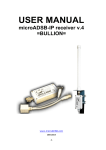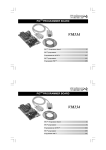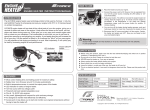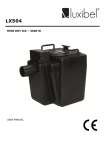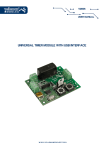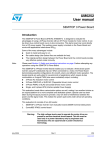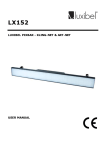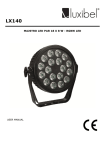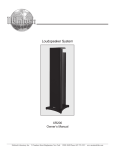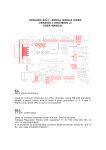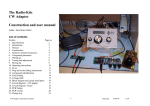Download "user manual"
Transcript
SOLDERLESS EDUCATIVE STARTERBOX Demo's on 12+ VELLEMAN NV Legen Heirweg 33 9890 Gavere Belgium Europe www.velleman.be www.velleman-kit.com 11 exciting projects which you can actually use. Projects featured in this box: LED with push button* ................................................................. Light a LED when a pushbutton is pressed (pag.10) A transistor as cuurent amplifier* .................................................................. Light a LED using a transistor (pag.12) Astable multivibrator** ......................................................................................... Let LEDs flash alternately (pag.14) Simple burglar alarm with LED indication and sound** .......................... Example of a simple burglar alarm (pag.16) Light detector**......................................................................... Switch on a LED when there is sufficient light (pag.18) Polarity tester* ............................................................................................................Check battery polarity (pag.20) Start-Stop circuit*** .................................................................................Control a LED using 2 pushbuttons (pag.22) Timer circuit*** ............................................................................... Make a LED switch off after a certain time (pag.24) Light switch*** .......................................................................... Make a LED switch on when it becomes dark (pag.26) Water alarm** ..........................................................................................Make a liquid level trigger an alarm (pag.28) Running light with 3 LEDs*** ...................................................... Make 3 LEDs light up shortly in succession (pag.30) Difficulty level * ** *** easy normal hard www.vellemanprojects.com : see "velleman EDU01" Pag. 3 Parts supplied with this kit: Breadboard The breadboard will hold all your experiments. The white lines show how the holes are electrically connected with eachother (Velleman part# SDAD102) Resistors R1 100 pag. 4 Various resistor values are supplied. They serve as current limiters or as voltage dividers. Resistors do not have a polarity. Resistors values are indicated by means of coloured rings. The unit of resistance is called ’Ohm’. ( see colour code table in the package) www.vellemanprojects.com Capacitors A capacitor is almost like a small battery, it can be charged using a power supply. Mostly used to stabilise or to filter out unwanted voltages. The unit is Farad: practical values are in µF, nF or pF. The supplied capacitor is an Electrolytic capacitor of 10µF and has a polarity, the long lead = + C... C... (Velleman part# 10J0E) Green & red LED How to bend the leads: A LED is a Light Emitting Diode, it can emit light using a small current (max 20mA with a 1.8V drop). Watch the polarity, long lead = + ! (Velleman part# L-7104LGD & L-7104LID) NG OK Flat side, shortest lead = (-) www.vellemanprojects.com Pag. 5 Push button A push button will conduct current when pushed and interrupt the current when released. (Velleman part# D6) Inside connection The supplied button has 4 connections, but only 2 are used. 2 are interconnected. Buzzer A buzzer produce a signalling sound to alert for a dangerous situation, timer confirmation, a button is pressed, ... The pitch of the buzzer can't be changed because the frequency of the oscillator is fixed. (Velleman part# SV3) pag. 6 www.vellemanprojects.com Transistors C A transistor is an amplification device. By means of a small current, a much larger current is controlled. Transistors come in two flavours, NPN and PNP-types, depending on the polarity. With this kit, you receive a BC557 (PNP) and a BC547 (NPN) transistor. A transistor has 3 pins: Base, Emitter and Collector. E (Velleman part# BC557B, BC547B) BC547 C B E B NPN LDR (Light Dependent Resistor) BC557 E B C C B PNP www.vellemanprojects.com E A Light Dependent Resistor behaves like a resistor. The resistance various on the amount of light falling on the device, it decreases with increasing light intensity. Velleman part# LDR04) Pag. 7 Flatcable 8x Including in this box you can find a multi-core cable. The wires must be separated from each other before use. This can be done using a wire-cutter or pair of scissors. Use the separate wires to connect components (indicated in the drawing by a thick black line) Velleman part# FC8) pag. 8 www.vellemanprojects.com PROJECTS www.vellemanprojects.com Pag. 9 Project 1: LED with push button As long as the push button is pressed the led will light * RED 9V 1K *Not included Flat side, shortest leg = (-) pag. 10 www.vellemanprojects.com Required parts: 9V battery*, 1000 ohm resistor (brown black red ), red LED, push-button How it works: As long as the push button is pressed, a closed circuit is formed that makes the current flow and the LED lights up. Current flows from the (+) of the battery to the push-button, resistor, (+) of the LED and via the (-) of the LED back to the battery. Using a 1000ohm resistor the current will be about 0.007A (7mA). Calculation of the resistor: resistor = battery voltage – LED voltage LED current resistor = 9V - 1,8V = 1000ohm 0,007 www.vellemanprojects.com Time to experiment: What happens when you swap (+) and (-) of the led? What happens when you replace the 1000 ohm resistor with a 100K ohm resistor (brown black yellow gold) ? Pag. 11 Project 2: Transistor acting as current amplifier Light up a LED using a transistor, use your finger as a switch * Jumper wire *Not included 1K 9V 1K K 47 C B E pag. 12 www.vellemanprojects.com Required parts: 9V battery*, 1K resistor (brown black red gold), 470K resistor (yellow purple yellow gold), red LED, BC547 transistor, wire jumper. How it works: In this circuit, the small current flowing through your finger will be amplified by the transistor. The base current that runs via your finger and resistor R1, is amplified by transistor T1. The amplified current flows through the LED and R2 making the LED lit. R3 will prevent the transistor for unwanted functioning. HINT: wet you finger to make the LED light up stronger. www.vellemanprojects.com Pag. 13 Project 3: Astable multivibrator (flashing LEDs) Let LEDs flash alternately ** 100K 9V 1K C1 1K *Not included C2 C WATCH THE CAPACITOR POLARITY pag. 14 100K B C E B E www.vellemanprojects.com Required parts: 9V battery*, 2x 1K resistor (brown black red gold), 2x 100K resistor (brown black yellow gold), 2x red LED, 2 x BC547 transistors, 2x 10µF electrolytic capacitors How it works: The 2 transistors alternately conduct because the capacitors are charged and discharged. The speed at which this happens depends on the capacitors (C1, C2) and the resistors (R1, R2). Use a higher capacitor and resistor value in order to extend the LED lighting time. The LED on-time can be calculated: T = 0,693 x R1(Ω) x C1 (F) T = 0,693 x 100.000 x 0.00001 = 0,693sec. www.vellemanprojects.com Pag. 15 Project 4: Simple burglar alarm with LED indication and sound. Make an alarm signal sound when the circuit is interrupted... ** 9V 100K 1K C B *Not included E 0,5m supplied wire pag. 16 www.vellemanprojects.com Required parts: 9V battery*, 1K resistor (brown black red gold), 100K resistor (brown black yellow gold), red LED, BC547 transistor, buzzer, 0,5m supplied wire. How it works: An alarm sounds when the normally closed security circuit (here indicated as ‘WIRE’) is interrupted. Replace this normally closed circuit (WIRE) by a normally closed window or door switch; when e.g. the window is opened the contact within the window switch is interrupted, the security circuit is opened and the buzzer sounds. The alarm signal ends as soon as the security circuit is closed again. www.vellemanprojects.com Pag. 17 Project 5: Light detector Switch on a LED when there is sufficient light ** 10K 9V 1K 10K B C *Not included pag. 18 E www.vellemanprojects.com Required parts: 9V battery*, 1K resistor (brown black red gold), 2x 10K resistor (brown black orange gold), red LED, BC547 transistor, LDR. How it works: A LED lights up when enough light hits the LDR. The LDR is a light sensitive resistor (Light Dependent Resistor), in dark conditions it has a high resistance, and in light conditions its resistance becomes low. Across the LDR is a positive potential which is fed to the base of the transistor enabling it to switch. Resistor R2 creates a switching point which determines when the transistor starts to conduct. Resistor R1 limits the current that flows through the LDR. www.vellemanprojects.com Pag. 19 Project 6: polarity tester. Check the polarity of a battery * GREEN RED 9V Jumper wire 1K *Not included pag. 20 www.vellemanprojects.com Required parts: 9V battery*, 1K resistor (brown black red gold), red LED, green LED, wire jumper How it works: When the 9V battery is connected to the circuit with the right polarity the green LED (good) will light up. Current can flow from the "+" of the battery through the green LED and via the resistor back to the "–" of the battery. The red LED (wrong) will not light up as it is polarised in the opposite direction. When swapping the connection of the battery (switch the red and the black wires) the red LED will light up. This way we can determine whether a battery is connected the right way or not. www.vellemanprojects.com GREEN RED Pag. 21 Project 7: Start-stop circuit. Control a LED using 2 pushbuttons *** E T2 B C 1K 1K 9V 1K 10K C Jumper wire T1 B E *Not included SW2 SW1 Jumper wire Jumper wire pag. 22 www.vellemanprojects.com Required parts: 9V battery*, 3 x1K resistor (brown black red gold), 10K resistor (brown black orange gold), red LED, 2 x push-button, 1x BC547 transistor, 1x BC557 transistor, 5 x wire jumper How it works: The “START” button will light up the LED; it will remain on when the pushbutton is released. To switch off the LED, press the “STOP” button. T1 and T2 are in state of rest (OFF, no current). By pressing the “START” button a current flows via R4 through the LED. At the same time the base of T2 is pulled low (was high via R1). Since the value of R3 is much lower than R1 the voltage on the base of T2 drops making it conduct and via the collector of T2 and R2. T1 also starts to conduct. From this point on, both transistors keep each other in conducting state, even when the “START” button is released. Pressing the “STOP” button will end the current flow towards the base of T1 and it will stop conducting. The circuit is interrupted and T2 will also stop conducting. The LED will turn off. www.vellemanprojects.com Pag. 23 Project 8: Timer circuit. Make a LED switch off after a certain time *** C E Jumper wire B 9V 1K 100K C Jumper wire B E 10µF *Not included Jumper wire pag. 24 10M www.vellemanprojects.com Required parts: 9V battery*, 1K resistor (brown black red gold), 100K resistor (brown black orange gold), 1M resistor (brown black green gold), Red LED, push-button, 2x BC547 transistor, 10µF electrolytic capacitor, 3 x wire jumper How it works: When pushing the push button shortly, the LED will turn on and after a while it will go out. By pushing the push button the capacitor will quickly charge; when releasing the button the capacitor will release its stored energy via both transistors – both will start to conduct and the LED will light up. The current needed to make T2 conduct is limited as T1 and T2 form a Darlington transistor circuit. The time needed to discharge the capacitor is also determined by resistor R1. The smaller R1 the faster the capacitor is discharged and the LED switches off. When R1 is removed, the capacitor discharges solely via the base current of T1. Switching off is a lot slower now and takes ± 1 minute. www.vellemanprojects.com R1 10M In electronics, the Darlington circuit is a structure consisting of two bipolar transistors connected in such a way that the current amplified by the first transistor is amplified further by the second one. This configuration gives a much higher current gain than each transistor taken separately. The total gain of both transistors can be calculated: ß = ß(T1) x ß(T2) Pag. 25 Project 9: Light switch Make a LED switch on when it becomes dark *** 10K 9V 1k 1k *Not included 10µF E C E C B B 10K 100 100K Jumper wire pag. 26 www.vellemanprojects.com Required parts: 9V battery*, 100 ohm resistor (brown black brown gold), 2 x 1K resistor (brown black red gold), 2 x 10K resistor (brown black orange gold), 100K resistor (brown black yellow gold), 2x BC547 transistor, 10µF electrolyte capacitor, LDR, Red LED, 2x wire jumper How it works: This circuit will make a LED switch on when it becomes darker. Transistors T1 and T2 form a Schmitttrigger circuit. The output of a Schmitt trigger is switched over at a certain voltage at the input (the trigger level). The purpose here is the switch the LED on or off completely. As long as there is no light R6 100K on the LDR there is no base current to T1 and it will not conduct. As long as this is the case, T2 will receive a base current via R2 and R3 and conducts; the LED will be on. When light shines on the LDR the voltage on the base of T1 rises. T1 will start to conduct when this voltage is higher than the voltage over R5 + Ube of T1. When this is the case, the base voltage of T2 drops and T2 does not longer conduct and the LED goes off. Because of the change in flow through R5 when the LED switches off, the threshold level for which T2 will conduct again in darkness also changes. www.vellemanprojects.com Pag. 27 wire Project 10: Water alarm Make a liquid level trigger an alarm ** 10K 9V MAX B *Not included C E C B 470K Do not use a flammable substance pag. 28 E www.vellemanprojects.com Required parts: 9V battery, 10K resistor (brown black orange gold), 470K resistor (yellow purple yellow gold), buzzer, 2x BC547 transistor, 2 wires How it works: The 2 sensor wires must be placed in a tank at a certain distance (e.g. use a drinking cup). Fill up the tank with a conducting liquid (e.g. water) until the level reaches both sensor wires. A small current will flow via R2 towards the base of T2. The base is protected against interference with a resistor R1. T1 & T2 are configured as a Darlington switch hence only a very small current is needed to make T1 conduct and activate the alarm sound. www.vellemanprojects.com Pag. 29 Project 11: Running light with 3 LEDs Make 3 LEDs without control light up successively 1K 100K 1K 100K 1K Jumper wire Jumper wire 9V 100K *** *Not included C B E pag. 30 C B E C B E www.vellemanprojects.com Required parts: 9V battery*, 3x1K resistor (brown black red gold), 3x100K resistor (brown black yellow gold), 3 x red LED, 3x BC547 transistor, 3x10µF electrolytic capacitor, 2x wire jumper This circuit makes each LED light up shortly in succession. The circuit consists of 3 identical channels. It is theoretically possible to expand; per LED a similar circuit is needed in series with the previous. The capacitor of the next channel is charged when the transistor of the previous channel is not conducting. As long as a certain transistor is not conducting, the relevant LED will light up. Capacitor C4 is added to the circuit to create a certain starting condition when connecting power and to ensure a good operation. Time to experiment: What happens when you change the value of R1, R2 and R3 to 10K? www.vellemanprojects.com Pag. 31 02 SOLAR ENERGY EXPERIMENT KIT 03 Fun solar powered projects. Learn all about solar energy. 04 PICTM TUTOR KIT Enter the world of microcontroller programming, easy step by step instructions. Includes programmer and test board. SOLDER EDUCATIVE STARTER BOX Learn how to solder, build different exciting projects. Includes spare components and demo boards. 05 USB TUTOR BOARD Learn how to connect your computer with the outside world, master the USB communication with tutorial examples. Play with LED indicators and learn how to drive LCDisplays. The Microchip name and logo, PIC, and PICmicro are registered trademarks of Microchip Technology Inc. in the USA and other countries. 06 SCOPE EDUKIT This board with different signals will teach you how to use an oscilloscope. Optimized instructions for use of our HPS140 oscilloscope. YouTube demo movies. Modifications and typographical errors reserved. © Velleman nv, Legen Heirweg 33 - 9890 Gavere (België) HEDU01 - 2011- ED1 5 410329 438111

































